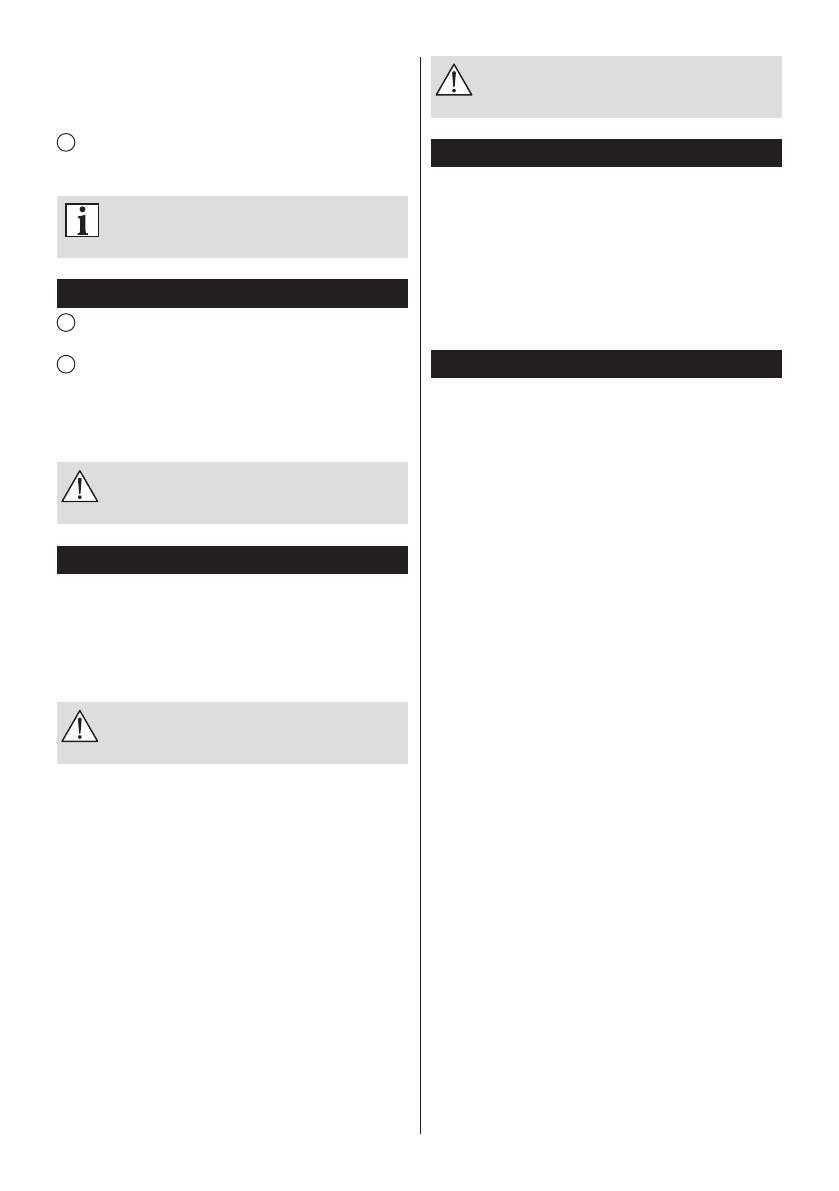
When centrifuging juice of small fruits, use the bowl for
●
small fruits (7), put it on the chute.
Pour the extracted juice into glasses or cups prepared
●
in advance.
3
The juice collector (9) is equipped with foam separator
(10), which task is to stop the thicker particles of juice and
foam.
We recommend natural version of juice, less
clear. In order to obtain such a juice it is
necessary to remove the foam separator.
After operation (juice centrifuging) (Fig. E)
1
Switch the juice extractor off, turning the switch (a) to
position „0”.
2
Unplug the appliance.
After the motor stops start to disassemble the juice
●
extractor in order to wash the parts (see „Preparing for
operation”).
Remove the accumulated pulp from the pulp collector.
●
Prevent the excess of the pulp collector. The
excessive pulp can pour out while leaning the
collector during removing.
Juice extractor maintenance rules
Clean carefully after each usage, to prevent drying of
●
juice and fruit remains.
Remove the dirt from the corners with a bottle brush or
●
tooth brush.
Clean the motor with damped cloth sprinkled with
●
washing up liquid. Then dry it.
When water or juice getting into the motor, stop
operation immediately and bring the appliance
to service for inspection.
The following elements of the equipment: juice bowl,
●
insert, and lid, bowl for small fruits, pusher and the juice
collector including foam separator should be washed in
hot water with wash-up liquid.
You can clean them in dishwashers in maximum
●
temperature 60°C.
The exception is a lter
●
(4). It should be washed with
hard brush (13) only, which is included to this juice
extractor equipment. Do not use any metal brushes to
clean the lter!
Some elements can change their colour after long-term
●
usage. It is not a defect.
Colour from carrot can be removed by cleaning the
●
surface with a cloth immersed in edible oil.
Dry carefully all parts after cleaning.
●
Assemble the juice extractor according to instruction
●
mentioned above (see „Preparing for operation”).
Roll the supplying cord inside the base of juice extractor
●
motor.
Pay a special attention to transparent plastic
parts. They are the most sensitive for hits and
falls. They can be easily damaged then.
What to do when ...
The juice extractor does not work:
Bring the juice extractor to service agent.
●
The juice extractor extracts little juice or vibrates:
Use the
●
TURBO function. If the problem still exists, switch
the appliance off; clean the lter from accumulated pulp.
Additionally, empty the pulp collector if it is full.
In case of mechanical lter damage, implicitly replace it
●
with a new one.
Fruit and vegetable juices preparation
Fruit and vegetables for juice extraction, should be fresh
●
and washed carefully. Vegetables should be cleaned
from sand and soil with running water and peeled.
Publications concerning juice preparation, recommend to
deep the vegetables into water with salt and citric acid for
5 minutes. Such prepared vegetables do not get darker
during processing and their juice has natural colour.
Berry fruits should be washed directly before using, so
●
that they do not loose their freshness.
The selection of fruit and vegetables depends on the
●
season of the year, taste likes or health recommendations.
The way of preparation inuences the nutritive value.
Juices should be made of juicy kinds of fruits and
●
vegetables, which should be ripe and fresh, to get the
juice of the perfect avour and fragrance.
The following vegetables are good for juice preparation:
●
tomatoes, carrots, celeries, beetroots, parsleys, onions,
cabbages, cucumbers, black turnip, rhubarb, etc. You
can also prepare juice of lettuce, spinach, leek and other
vegetables as part of diet.
The following vegetables can be added to juices
●
chopped: radish, chives, green parsley, dill, cress.
Fruit juice can be made of almost all kinds of fruit.
●
Apples, peaches, apricots and plums should be blanched
●
with boiling water on the strainer.
Remove the stones from the fruit, which have it, to
●
prevent damages of the juice extractor.
Juice extracting of plums, blueberries, soft pears, apples
●
or other fruit is inconvenient. The esh of these fruit
becomes a spongy pulp, which blocks the lter holes.
You can use these fruit mixing a small amount of them
with other fruit or vegetables, it is also necessary to
clean the lter more often.
You can extract a small amount of grapes juice, but it is
●
necessary to put whole bunch to the chute after removing
ligneous stalk.
Cut the radical vegetables and hard fruit into pieces small
●
enough for the chute. Cut the apples into pieces (if they
are not small enough to put them whole into the chute)
without peeling and removing seed cavity.






